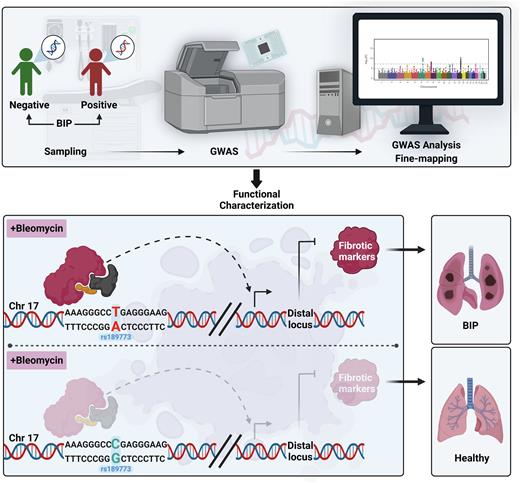Abstract
Background: Bleomycin has been used as a cornerstone in the treatment of a variety of cancer types including Hodgkin Lymphoma (HL) and Germ Cell Tumor. Unfortunately, bleomycin has its complications, such as Bleomycin-induced pneumonitis (BIP) occurring in ~20% of patients and is fatal in 4-5%. In addition, there are no trials guiding effective treatment for BIP. While brentuximab as an alternative for bleomycin has shown good results in HL, it is still not considered as a standard first line treatment for most of the world.
We aimed to investigate the significance of known genetic associations [(HFE rs1799945 (H63D) and BLMH rs1050565 (I443V)] in Asian patients, and identify previously uncharacterized genetic biomarkers associated with the predisposition to BIP. Through functional studies, we also sought to investigate the mechanisms in which these genetic biomarkers led to BIP.
Methods: We analyzed 133 HL patients treated with bleomycin in Singapore. Clinical data was extracted from electronic medical records, BIP was characterized and graded by CTCAEv4. Genomic DNA was genotyped using Infinium Global Screening Array-24 v1.0 for 700,078 markers. Alt-R® CRISPR-Cas9 was used for the gene-editing experiment.
Results: A total of 21.43% of patients developed clinically significant BIP, defined as CTCAEv4 ≥ Grade 2. Cumulative bleomycin dose was significantly lower in the BIP cases, as BIP patients had bleomycin discontinued from future therapy. All other clinical features were not significantly different between the groups. We replicated an association of HFE rs1799945 (H63D) with BIP and identified 4 new potential genetic predictors. LOC105371512 rs189773 was ranked the top loci.
We genotyped 4 lung cancer cell lines. Comparing rs189773 CC and TT genotypes, CC had lower expression of pro-fibrotic markers, while higher expression of anti-fibrotic ones. We next used CRISPR/Cas9 to generate cells with either CC or TT genotype at rs189773 locus using the same cell line (A459). Interestingly, the BLMH protein expression level showed a reduction in A549(TT) compared to A549(CC), with a more remarkable effect in the presence of bleomycin. Screening the fibrotic biomarkers further revealed that growth factors and pro-fibrotic interleukins were up-regulated in A549(TT) compared to A549(CC) cells especially when the cells were treated with bleomycin. Next, we found that this SNP is located in a transcriptionally active region, with a higher activity level for the presence of T at the position compared to C. The rs189773-flanking region was subsequently shown to enhance the transcription level of distal genes with consistent effects on the profibrotic growth factors and cytokines. The qPCR study demonstrated that BLMH was not regulated at the mRNA level. We thus treated the cells with bleomycin and a 26S proteasome inhibitor, bortezomib. Interestingly, the bleomycin-induced down-regulation of BLMH protein was rescued upon co-treating the cells with both bleomycin and bortezomib. This proteasome inhibitor drug consistently diminished the heightened levels of profibrotic markers induced by bleomycin.
Conclusion: In conclusion, in the first pharmacogenomics-GWAS study on BIP in Asians, rs189773 was ranked the top likely loci, with functional studies showing that this variant is in an enhancer region, modulating the cellular response to bleomycin via regulation of a distal locus, BLMH, and profibrotic growth factors. At the post-translational level, inhibition of the 26S proteasome by bortezomib restores BLMH expression and suppresses profibrotic growth factors. This study provides insights into future screening targets and potential new treatment options for BIP.
Disclosures
Ong:SymBio Pharmaceuticals Limited: Research Funding. Chng:Hummingbird: Research Funding; Takeda: Honoraria; Novartis: Honoraria; Abbvie: Honoraria; BMS: Honoraria; Celgene: Honoraria, Research Funding; J&J: Honoraria, Research Funding; Amgen: Honoraria. Jeyasekharan:Perkin Elmer: Other: Travel Funding; IQVIA: Other: Consultancy Fee; Janssen: Other: Consultancy Fee, Research Funding; Antengene: Other: Consultancy Fee; AstraZeneca: Other: Consultancy Fee, Research Funding; Turbine Ltd: Other: Consultancy ; MSD: Other: Consultancy Fee.
Author notes
Asterisk with author names denotes non-ASH members.


This feature is available to Subscribers Only
Sign In or Create an Account Close Modal